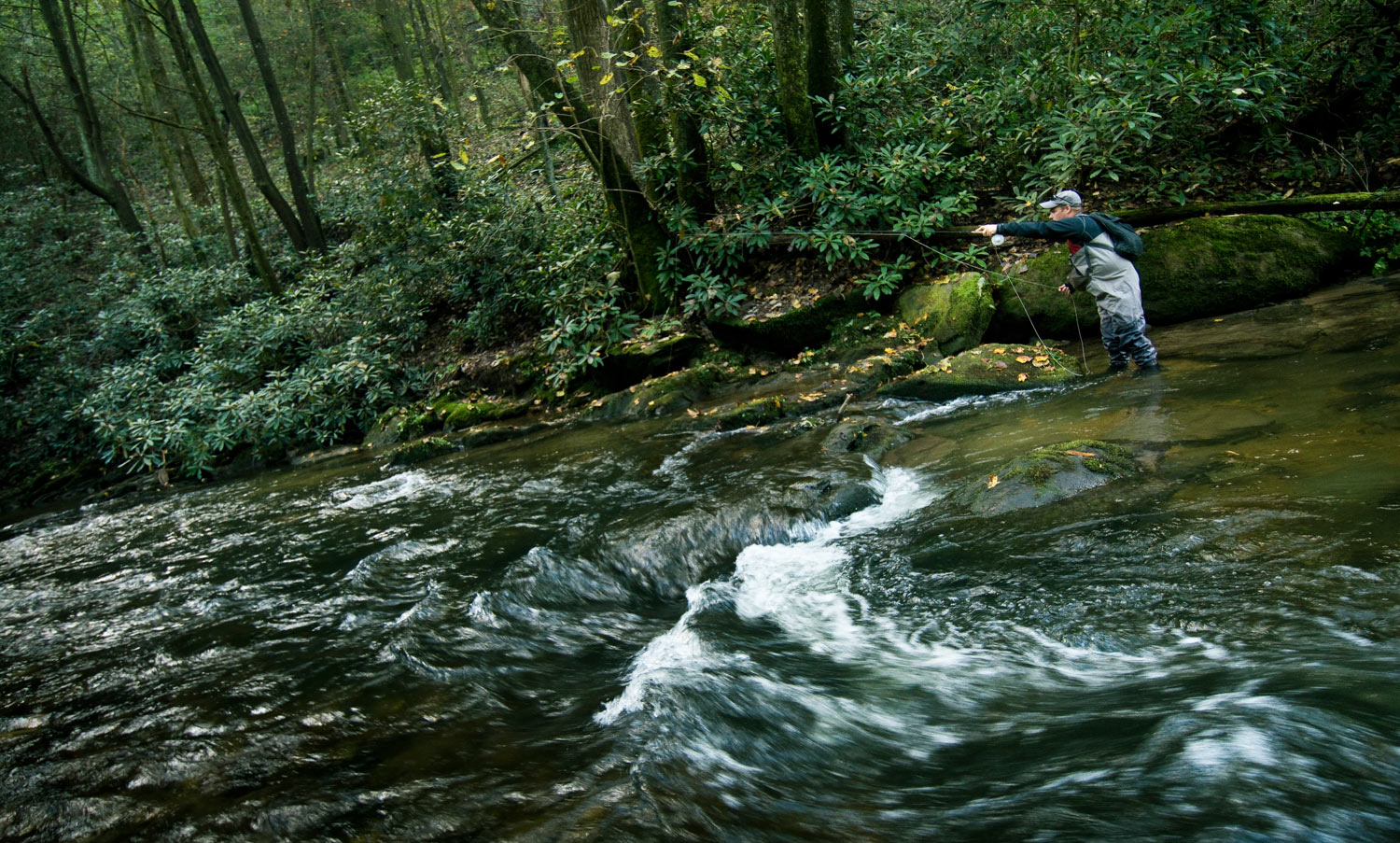By Jason Tucker
I’m always looking for ways to get an edge while trout fishing.
Trout are incredibly sensitive to their environment. They are constantly on the lookout for both food and predators. In an instant they can go from feeding on mayflies to fleeing an otter or eagle. Or you.
Insert yourself, the angler, into the happy world of the trout. Here you come, hulking four to six feet above the water, pushing a bow wave, splashing water all over the place, feet grinding the gravel, and it’s a surprise that trout ever come back out to feed. You and I would need therapy after such an encounter.
IMHO anglers do not pay enough attention to the effect of sound on trout, and I can’t tell you the number of times I’ve seen anglers wade directly into a hole or run with the fish and proceed to put them down before they ever make a cast. Here is a tip to help you out.
Keep some sort of “sound barrier” between you and the fish.
The Smoky Mountain streams I live near offer many such barriers. They are mostly a series of plunge pools that tail out to some rocks before plunging into the next pool. When approaching such a pool, stand below the tail out rocks, don’t enter the pool. The fish hear you every time and get cautious. Only after you have fished everything you can reach from this position should you enter the pool or run to fish the rest of it.
In Michigan and the Midwest the tail end of a pool or feeding run will often have a pour-over log below it. Stay behind the log, resist the temptation to step over it even if the fish are yet well upstream. As long as the fish are within casting distance, use the noise of the water pouring over the log to mask your approach. Resist the urge to step over it to cast to the fish.
Even where there are no rocks or logs to muffle the sound of your approach you often still have options. For instance, many pools or feeding runs tail out into a shallow riffle area. If at all possible, stay below the shallowest part of the riffle to cast to fish feeding in the run or pool above. The moment you step into the calm, deeper water above the riffle, you will get a negative reaction from fish.
Once you take advantage of the “sound barrier” and see the difference it makes, you will start to look for other such situations and utilize them to your advantage. Catch more trout- don’t break the “sound barrier”!
Jason writes the fine blog Fontinalis Rising
Jason Tucker
Gink & Gasoline www.ginkandgasoline.com hookups@ginkandgasoline.com Sign Up For Our Weekly Newsletter!

Thanks for this very good tip. I see myself often worrying if the trout can see me, but i seldom waste a thought about if they might hear me… Will pay more attention to that in the future for sure!
After bonefishing for the last 3 months, I can’t tell you how paranoid I am about sound. I can honestly say the majority of people I fish with pay little to no attention to this variable in the pursuit.
Excellent advice, compactly written. Nice.
Here is some ‘sound’ advice when wading for trout in rocky streams:
Ditch the cleats!
FELT = STEALTH
And of course sound travel quite well in water. A stealthy low visibility aND quiet feet on the bank is very advantageous. I know i.have often lamented the fish I’ve spooked upon a backside approach. But I have also been surprised at the number of fish I have caught right after someone.has blasted through a hole. Once I caught a very nice Brown on a throw away cast right on the back wheel of a mountain biker wading a fording spot on a very high mountain stream in CO. Shocked us both.
I’ve always operated under the belief that water is the best sound and vibration conductor in the natural environment. If I can hear the sounds I’m making when wading, ie: the crunching of gravel, the grinding of loose rocks under my feet, it must sound like an avalanche to tge trout. Double -layer felt soles work best, but even then careful wading is a no-brainer.
I’ve done 3 drift dives on our most popular trout river, and on two of those been amazed at how loud was the sound of anglers wading over a freestone bottom.
I hiked in 8 miles. Some young Church group showed up 43 hours later.. They decided that they needed to swim and throw rocks at the 11k foot lake. Sigh… Well at least…. I was quite…
Shoulda hiked in 9 miles to the next lake!
The very first lesson taught to me by my father as I watched him fly fish when I was 3-4 years old, was to be very quiet because the fish can hear you. Always whisper if you must talk. Walk quietly don’t shuffle your feet. Stay out of the water unless absolutly necessary (my father never owned a pair of waders). Being quiet and invisable are more important than what fly you use, but never ever make your fly “splash”!